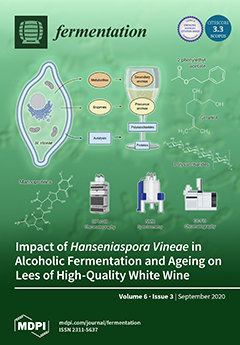In recent years, many novel xylose-fermenting yeasts belonging to the new genus
Spathaspora have been isolated from the gut of wood-feeding insects and/or wood-decaying substrates. We have cloned and expressed, in
Saccharomyces cerevisiae, a
Spathaspora arborariae xylose reductase gene (
SaXYL1)
[...] Read more.
In recent years, many novel xylose-fermenting yeasts belonging to the new genus
Spathaspora have been isolated from the gut of wood-feeding insects and/or wood-decaying substrates. We have cloned and expressed, in
Saccharomyces cerevisiae, a
Spathaspora arborariae xylose reductase gene (
SaXYL1) that accepts both NADH and NADPH as co-substrates, as well as a
Spathaspora passalidarum NADPH-dependent xylose reductase (
SpXYL1.1 gene) and the
SpXYL2.2 gene encoding for a NAD
+-dependent xylitol dehydrogenase. These enzymes were co-expressed in a
S. cerevisiae strain over-expressing the native
XKS1 gene encoding xylulokinase, as well as being deleted in the alkaline phosphatase encoded by the
PHO13 gene. The
S. cerevisiae strains expressing the
Spathaspora enzymes consumed xylose, and xylitol was the major fermentation product. Higher specific growth rates, xylose consumption and xylitol volumetric productivities were obtained by the co-expression of the
SaXYL1 and
SpXYL2.2 genes, when compared with the co-expression of the NADPH-dependent
SpXYL1.1 xylose reductase. During glucose-xylose co-fermentation by the strain with co-expression of the
SaXYL1 and
SpXYL2.2 genes, both ethanol and xylitol were produced efficiently. Our results open up the possibility of using the advantageous
Saccharomyces yeasts for xylitol production, a commodity with wide commercial applications in pharmaceuticals, nutraceuticals, food and beverage industries.
Full article





